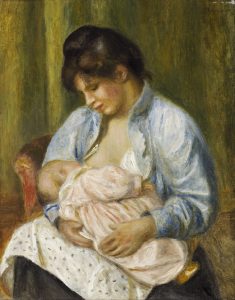 When Mary and I had our babies breast feeding was rare. It was reserved for the lower social class and was seen, at best, as a sign of poverty. I was an impoverished medical student and Mary was a new mom, so we challenged society and she attempted to nurse our first son.
When Mary and I had our babies breast feeding was rare. It was reserved for the lower social class and was seen, at best, as a sign of poverty. I was an impoverished medical student and Mary was a new mom, so we challenged society and she attempted to nurse our first son.
It was not a good experience for her, or him. Her milk leaked into her clothing and the bed. Poor baby was starving because there was no milk left for him, it was all lost in the pads she wore to protect whatever she was near. There were no support groups around at that time and Mom was as unhappy as our crying, hungry baby boy. Her doctor gave her a shot to stop the milk and we bottle fed baby and his subsequent sibs. They have all done well in spite of it all.
Today is a different story! Breast feeding is the purview of the well to do, middle class, and the poor. It should be universal for all moms and their babies. Today, to help make that effort a reality, there are support groups in every hospital newborn nursery.
Multiple studies have shown that human milk is truly best for babies and for their moms. Let’s look as some stats from the American Academy of Pediatrics policy on breast feeding.
According to the AAP, “…breastfeeding protects against a variety of diseases and conditions in the infant such as: diarrhea, respiratory tract infection, necrotizing enterocolitis (a problem with the intestines usually in pre-mature babies, which is often fatal), sudden infant death (SIDS), otitis media, and childhood obesity. In addition mother’s milk reduces the infant’s risk of type 1 and type 2 diabetes, lymphoma, and leukemia.”
Additionally, a study from Sweden showed that during the first 7 months of life urinary tract infections were 3.6 times greater in non-breast fed infants than those on breast milk. Furthermore, premature babies do better on human milk than commercially prepared formula. Those who are too premature to nurse can be given milk that their mother has pumped from her breasts. NICU (Newborn Intensive Care Unit) nurses will help the new mother learn how to extract, bottle, and store her milk.
The AAP’s policy concludes, “It has been calculated that more than 900 infant lives per year may be saved in the United States if 90% of mothers exclusively breastfed for 6 months”.
That’s the good news, the not so good news is that while 75% of US mothers begin breast feeding only 43% are still nursing at 6-months. The AAP recommends “… exclusive breastfeeding for about 6 months, followed by continued breastfeeding as complementary foods are introduced, with continuation of breastfeeding for 1 year or longer as mutually desired by mother and infant.”
That might be a little extreme for many women, but those who take that advice will note both short- and long-term health benefits for themselves. Benefits include lower risk for post-partum depression, and even more important, reduction in breast and ovarian cancer. Mothers with a cumulative lactation history of 12 to 23 months had a significant reduction in hypertension (high blood pressure), hyperlipidemia (high cholesterol), cardiovascular disease (heart attack), and diabetes. Nursing mothers also returned to pre-pregnancy weight and shape faster than their non-nursing friends.
An analysis by economic experts indicated that: “…if 90% of US mothers would comply with the recommendation to breastfeed exclusively for 6 months, there would be a savings of $13 billion per year.” WOW, that’s worth striving for! Once again, mothers come to the aid of their country.
Years ago a friend told me that there have been a few advances over the years and it’s best to go with them. “Don’t be the first to pick up the new,” he said. Then added, “Nor the last to leave the old behind.” Thank you Jim.
